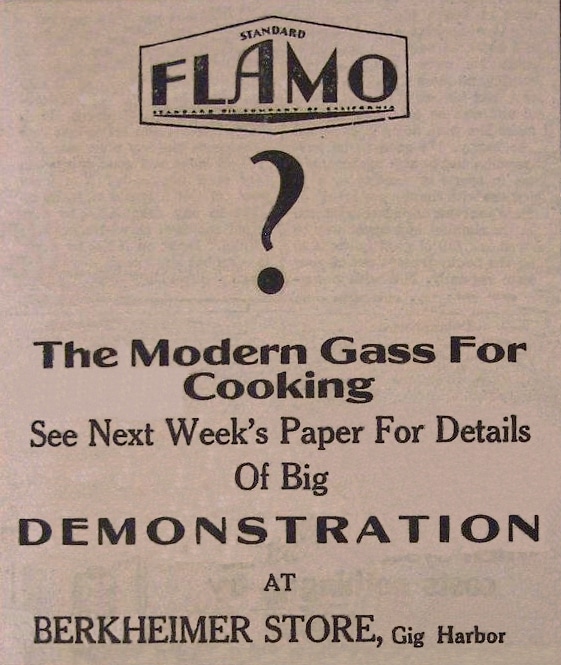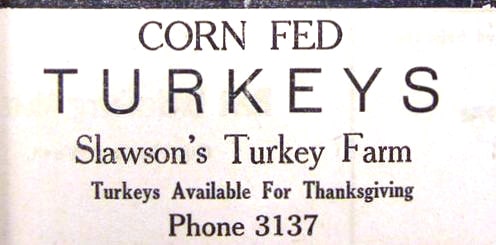Arts & Entertainment Community
Gig Harbor Now and Then: If you figured out what Flamo is, you’re really cooking with gas
The setup to our last Gig Harbor Now and Then local history question was very simple: In 1930, Flamo arrived in Gig Harbor. It’s still there, although is now known under another name.
Arts & Entertainment Sponsor
Arts & Entertainment stories are made possible in part by the Gig Harbor Film Festival, a proud sponsor of Gig Harbor Now.
Question: What is Flamo?
Answer: propane.
“Flamo” was the trade name of the Standard Oil Company of California’s propane.
The first mention of Flamo in The Peninsula Gateway, on March 28, 1930, almost explains it, but not quite: “Paul Lamoreux has taken up a new department work in Standard Oil activities here. This work consists of looking after the sales end of a new commodity, for this section, known as ‘Flamo,’ or cream of mineral gas. This product is really compressed natural gas, handled in the form of a liquid, and can be used for lighting, heating, cooking, and is sold at a price equal to 2c per k.w. of electricity.”

Flamo’s introduction to Gig Harbor was held at the Berkheimer Store in April, 1930. This ad appeared in the April 18, 1930, issue of The Peninsula Gateway, and was found at the Harbor History Museum.
The Berkheimer Store was chosen to introduce Flamo because it was adding to its inventory a line of heating and cooking appliances that burned the bottled gas.
Slawson’s Turkey Farm
Considering the advertisement for the demonstration of Flamo, a natural follow up question would be: Where was Berkheimer’s store? But it’s been bumped for a more seasonal topic, Thanksgiving turkeys.
There are still more than a few senior members of the Peninsula community who remember the Slawsons. Siblings Cynthia, Bob and Carolyn (and, some years later, Bob’s boys Robert and Danny) all attended Peninsula schools.
Bob’s parents, Ellwel and Charlotte, brought their family to the Peninsula from Montana in the early 1940s. They started a farm, raising turkeys and pigs. The birds must’ve been the better sellers, as they named the business Slawson’s Turkey Farm.

Slawson’s Turkey Farm Advertised regularly in The Peninsula Gateway in the 1940s. This 1946 ad was found in the Harbor History Museum.
In 1947, Ellwel took a job with the federal government in Alaska while the family stayed behind to run the farm. In 1948 he and Charlotte moved to Anchorage permanently.
For the several years the Slawsons operated their farm, the Peninsula had a local source for its holiday turkeys. The obvious question is:
Where was Slawson’s Turkey Farm located?
Hints: It wasn’t tucked away in a far-off corner of the Peninsula, or hidden on a dead-end road. It fronted what is still a very busy street today.
We’ll have the answer on Dec. 4. If that’s too far in the future, and you simply can’t wait, try this: drive around the main roads of the Peninsula for a few hours with the radio off and the windows down. If you pass a spot where you’re absolutely convinced you can hear the ghostly gobbles of tens of thousands of long-ago main courses, that’s probably the place.
Either that or your water pump’s going out.
If you do find it, by all means, please go to the Gig Harbor Now Facebook page and tell us about the experience. Was it spiritual in nature? Life-changing? Did it make you hungry?
Although entirely unintentional, it’s worth noting how beautifully the previous subject compliments the current one. No doubt many a Slawson turkey was cooked with Flamo.
Greg Spadoni of Olalla has had more access to local history than most life-long residents. During 25 years in road construction working for the Spadoni Brothers, his first cousins, twice removed, he traveled to every corner of the Gig Harbor and Key Peninsulas, taking note of many abandoned buildings, overgrown farms, and roads that no longer had a destination. Through his current association with the Harbor History Museum in Gig Harbor as the unofficial Chief (and only) Assistant to Linda McCowen, the Museum’s primary photo archive volunteer, he regularly studies the area’s largest collection of visual history. Combined with the print history available at the Museum and online, he has uncovered countless stories of long-forgotten local people and events.

